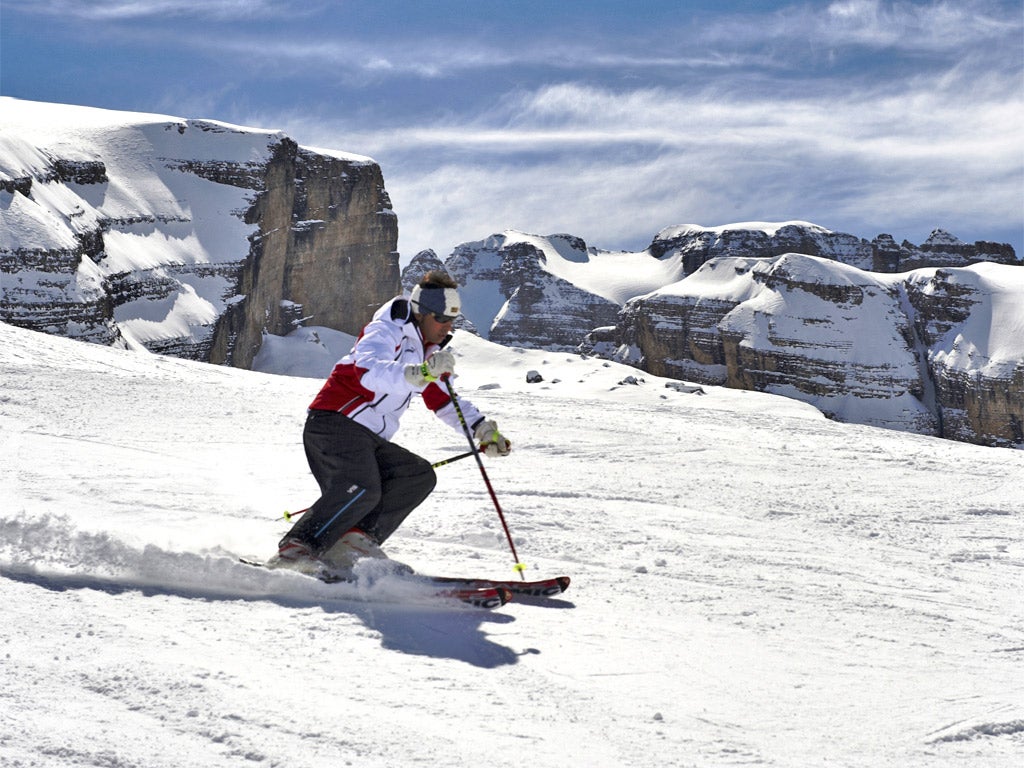Steep thrills: Italy's recession-hit resorts put faith in hair-raising black pistes
Testing a skier’s limit is at the heart of plans to reverse a drop in holidaymakers

In the battle to attract skiers after the first big snowfalls of the season, the Alps’ recession-hit resorts are counting on their scariest pistes to bring in the winter thrill-seekers.
And the appeal of the most hair-raising descents is such that Europe’s ski resorts are now battling to produce steeper and steeper descents.
Switzerland’s famous St Moritz has increased the maximum steepness of its already petrifying Lagalb piste to a scarcely believable 41 degrees to the horizontal slope on average, in order to claim the crown as Europe’s steepest black run. The resorts PR people describe it as “a sheer delight for adrenaline junkies”.
The Franco Berthod slope in Italy’s La Thuile resort is now said to beone degree steeper at 37 degrees. Close behind in third spot in the Italian Dolomites, is the Plan de Corones, at 36 degrees.
Officials in Italy’s top ski villages are in no doubt about the lure of wickedly difficult runs. An agent of the police unit patrolling the slopes at Moena in Italy’s north-Eastern Trentino region told La Repubblica: “All you need to do is put up a notice telling people that the piste is reserved for expert skiers and you’ll instantly find a queue because there’s a huge desire for people to test their limits – even among those who should realistically stick to the easier pistes.”
Some of the most challenging black pistes (colour-coded to denote difficulty, with black being the hardest to ski) are now so steep, that snow-cat vehicles which crawl up the slopes every night to flatten and recondition the snow have to be fastened from a winch to ensure they don’t slither down the mountain.
But the commercial incentives for maintaining – or introducing – pistes such as Madonna di Campiglio’s famous Spinale Direttissima or Mayrhofen’s appropriately named Harakiri slope in Austria are clear.
Renzo Minella, the president of Dolomite Tourism, said the hardest pistes were in huge demand. “It’s clear that the ambition of every skier is to measure themselves against difficult slopes and therefore the very rapid pistes have an added value, especially for the ski resorts that want to host the competitions at the highest level,” he said.
Much of the Alps has been struggling to attract skiers in tough economic conditions. According to Ansa news agency, the average cost of a week in the Italian mountains in peak season will be €932 (£775) per person this year and €2,240 (£1,870) for a family – without taking into account spending money.
But Mr Minella added that guaranteeing safety and maintaining the super-steep black runs could be “very complicated and costly”.
After a spate of deaths in the Alps in recent years, authorities have sought to introduce more police patrols and even punishments for skiers who behave dangerously or put themselves or others at risk.
In Switzerland, fines of SFr1,000 (£675) have been handed out to irresponsible skiers, and some have been asked to pay damages and to meet the cost of rescue operations – often tens of thousands of Swiss francs. Some offenders have also had their ski passes confiscated and been put on resort blacklists.
But most of the dangerous incidents have occurred as a result of skiers ignoring warnings about off-piste activity,
Statistics suggest that the rate of serious injuries on the exceptionally steep black runs is lower than average. Mr Minella said their reputation – and the sheer challenge they presented – meant that even the best skiers approached them with caution.
Tone Valeruz, one of Italy’s best-known “extreme skiers” told La Repubblica that the piste he considered among the most challenging was the Piculin slope at San Vigilio di Marebbe in the Dolomites. “It can scare even a very good skier, not only because of the vertical decline but also because of the lateral slope,” he said. “If you fall, you fly off the piste, especially when the bottom part is icy.”
He noted that on the steepest of descents, staying upright was more about controlling your fears than your technique.
Subscribe to Independent Premium to bookmark this article
Want to bookmark your favourite articles and stories to read or reference later? Start your Independent Premium subscription today.

Join our commenting forum
Join thought-provoking conversations, follow other Independent readers and see their replies